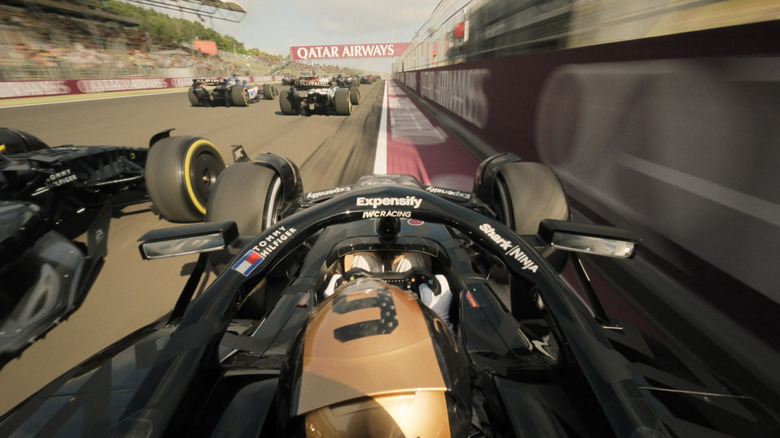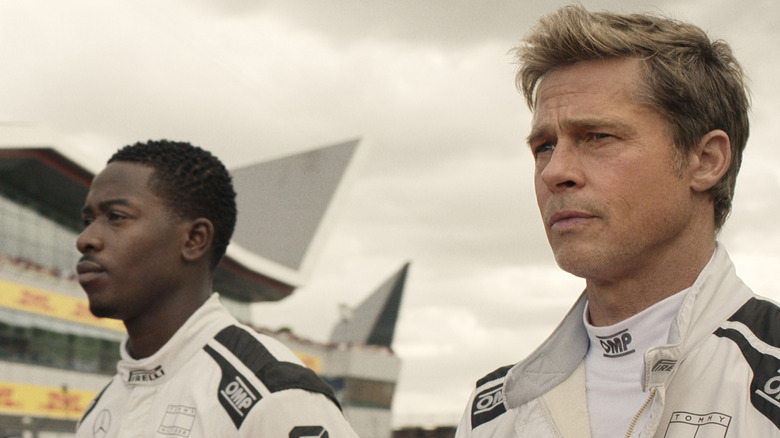F1 Crash Course: Terms And Racing Basics To Know Before You See The Movie
Joseph Kosinski's "F1" movie is designed to welcome both seasoned fans of the sport and casual moviegoers alike. If you've never watched a Formula 1 race or seen an episode of Netflix's popular "Drive to Survive" series, you'll still be able to follow the plot just fine: Racecar goes vroom vroom, Brad Pitt wants to win, etc. But there's also a good bit of Formula 1 jargon scattered throughout the film that the script doesn't go out of its way to explain.
Part of what makes "F1" so fun is that it shows love to the whole sport of racing, not just Formula 1. That particular league is treated as the pinnacle of the sport, to be sure, but we also get some great scenes featuring events like the 24 Hours of Daytona and the Baja 1000. If you've ever seen a NASCAR race, you'll have a leg up in this movie over someone who's never been to a track before. But even then, Formula 1 is a highly specialized form of auto racing, and it has plenty of unique quirks.
From "dirty air" to the DRS zone, let's get you caught up on some of the basic phrases and racing principles before you see "F1."
Box, DRS, and other Formula 1 terminology
While "F1" is a very accessible movie, it doesn't give any big exposition dumps explaining Formula 1, the format of the season, how race weekends are structured, or the mechanical details referenced at points throughout the film. As you watch, you'll pick up a wide array of lingo, so let's run through some of it quickly and give a few definitions:
-
Box — A slang term referring to the pit lane. When a driver or their racing crew says "box this lap," or something similar, they are calling for a pitstop to change tires and refuel.
-
DRS — Stands for Drag reduction System. This refers to a part of the car's rear wing that can open up like a series of slots to reduce wind resistance and thereby increase speed. DRS can only be activated on designated areas of each track when a driver is within one second of the driver in front of them. It is a mechanic designed to make it easier to pass on straightaways, making races more exciting.
-
Dirty Air — Air that has recently been disturbed by other cars. Dirty air in corners can be a problem for the trailing driver as there is less stationary air to provide downforce (and, therefore, grip) for the aerodynamics of the car. Dirty air in straights, on the other hand, is called "slipstream" and can actually be helpful for the trailing car in its attempts to pass.
-
Tow — The effect of being pulled in by a leading car while slipstreaming, gaining some speed.
-
Soft/Medium/Hard tires — Each race of the season designates three tire hardnesses from a total of six, as well as "intermediates" and "wets" for rainy races. Each driver must use at least two different tire compounds over the course of a race.
-
P1, P2, etc. — Refers to a driver's position in a race (first place, second place, etc.).
-
Chicane — A curvy, often s-shaped section of a track.
-
Safety Car — A car that drives onto the track after minor collisions, accidents, or track disruptions to keep racers under a slower pace and prevent passing while the issue is dealt with.
-
Pole Position — The lead starting position for a race, earned in qualifying.
-
The Grid — The arrangement of starting boxes where cars begin the race. Used as slang in the same way "pitch" or "field" might be used in other sports.
How the F1 movie uses real Formula 1 concepts in the story
Now that you know some of the verbiage, a lot of the race moments in "F1" may make a lot more sense. The characters Sunny (Pitt) and Joshua Pearce (Damson Idris) refer to the "tow" at various points in the film, for instance, while driving together as a team, with the lead car helping to give a boost to the one behind. The movie also features an honestly bizarre number of safety cars due to Sunny's highly questionable, aggressive driving style.
In addition to the actual terminology, there are some core race concepts that will help you understand the story of the film a bit better. In Formula 1, each team fields two drivers in the same car design, but only the top 10 of the 20 drivers on the grid earn points for their teams. First place (or P1) gets 25 points, second gets 18, and third gets 15, but the numbers drop off dramatically, with only four points for eighth place, two points for P9, and a single point for P10.
The more you understand about how Formula 1 actually works, the more you may realize that the actual plot of "F1" doesn't make a whole lot of sense. The ways in which Sunny and JP are able to eke out underdog performances would be incredibly difficult in the real world of F1 racing, and some key bits of the sport, like qualifying, are ignored altogether. Still, "F1" is a fun ride, with a lot of love paid to one of the most exciting competitions on the planet.
"F1" is now playing in theaters.


